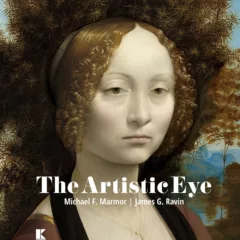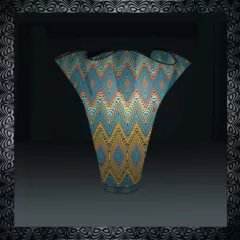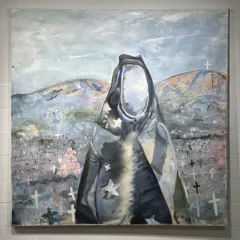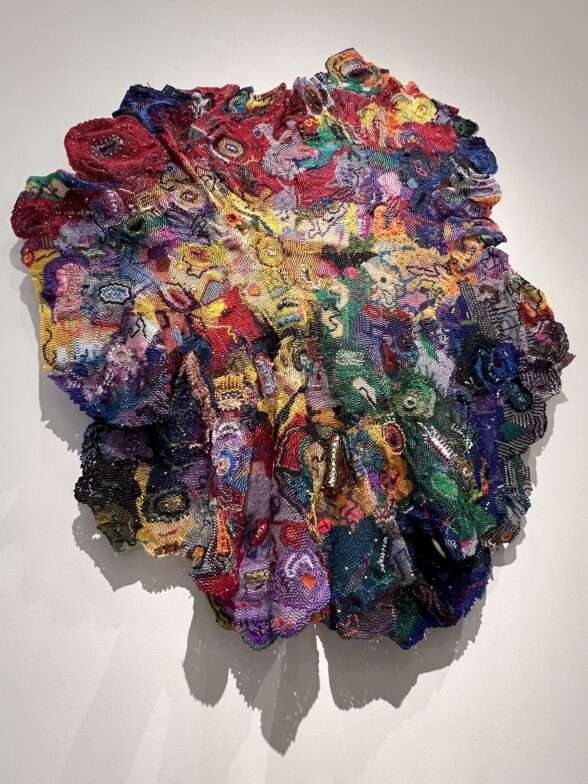
Joyce J. Scott is a force of nature. Her fifty-year retrospective exhibition at the Baltimore Museum of Art is an immersive experience that, if possible, should be viewed more than once. It was just chosen by Artnet as one of the must-see U.S. exhibitions this Spring. It will be traveling next to their partner on this project, the Seattle Art Museum. The exhibition includes large, newly made works as well as those representing the major themes that have informed Scott’s long career—social and political justice, racism, and cultural diversity. She does not shy away from difficult topics like lynching and gun violence.
Scott is a multi-talented artist who not only creates sculptures, clothing, and jewelry with fiber, textiles, glass, and beads, but who also has a long history of performance. She is a printmaker too and the work on view at her gallery includes a retrospective of her prints. The BMA exhibition is accompanied by a rich catalog with extensive interviews with the artist as well as essays with and by both established scholars, such as Leslie King Hammond, Valerie Cassel Oliver, Tiffany E. Barber and Lowery Stokes Sims, and artists who consider Scott a mentor and inspiration like the 2024 Venice Biennale artist Jeffrey Gibson and multidisciplinary artist Sonya Clark whose work is currently on view at the Museum of Art and Design.
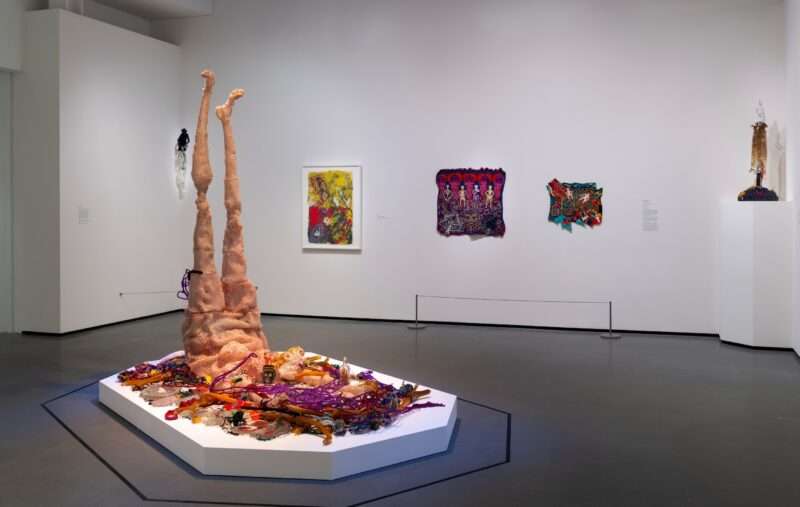
Text panels in the exhibition are very helpful. Scott has a lot to say, which she presents with a dark humor. She states that she is both a visual artist and a trickster. In her interview with Leslie King Hammond, she explains the role of spirituality in her work, defining the differences between African American and African spirituality. Scott was raised in the Pentecostal Apostolic church and sees the church as a kind of university for the those who came out of slavery, but also suggests there is an alchemical and magical aspect to African American churches.* Her work emerges out of these various traditions as well as her familial background, her education, and her travels.
It seems that Scott was everywhere, scooping up knowledge and experiences that impacted her artistic practice. After graduating from the Maryland Institute College of Art, she earned her MFA in Mexico at the Instituto Allende, introducing her to very different ways of making. Following this she traveled to Guatemala, Panama, Peru, and Cuba. She continued to travel extensively, learning about indigenous cultures and artistic practices along the way. Her glass experiences include those in Italy and Pilchuck.
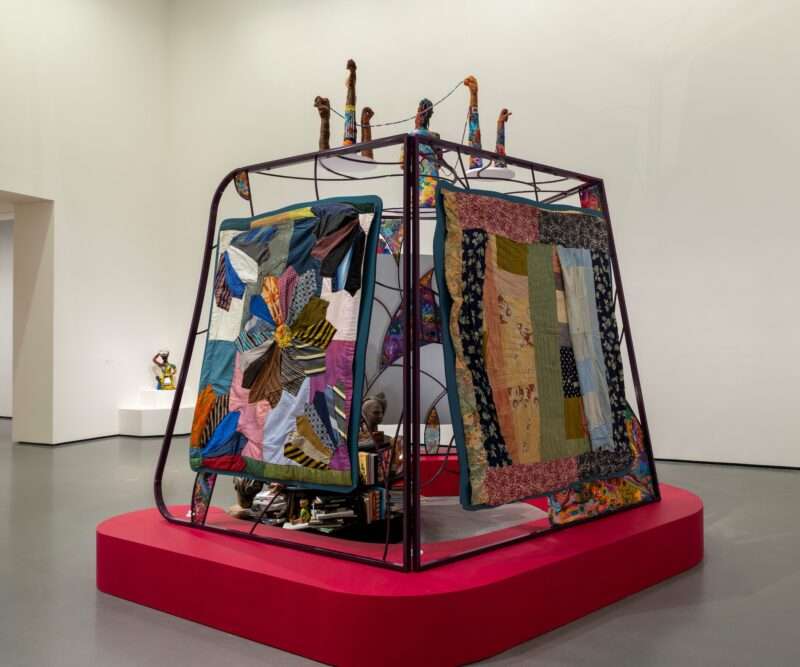
Upon entry into the first gallery the viewer encounters a large installation that is a homage to Scott’s heritage in making, handed down through her family. Titled “The Threads That Unite My Seat to Knowledge,” the work includes four heirloom quilts that cover the exterior of a structure inspired by Asian yurts, European cathedrals, and the communal quilting frames of her mother’s youth as well as west African masquerade garments. These quilts were made by her mother, godmother, grandmothers, and maternal grandfather. Scott explains that her creativity and imagination were inspired by her mother (Elizabeth Talford Scott) and her independence and drive by her father (Charlie Scott Jr.). No longer on view, is an exhibition of her mother’s work, but you can see images of it and watch several very informative videos that discuss Elizabeth Talford Scott’s quilts in which Joyce Scott comments on her mother’s artistry at the links below. There was also a catalog published for this show. Her mother encouraged her and at times they collaborated. Their relationship was both personal and artistic. She learned about quilting but also embroidery beading from her mother, later adding the peyote stitch for beading which she learned from Fife Wilson at Haystack Mountain School of Crafts in 1974.
In this same front gallery, Scott includes a sculpture in each corner of the room to impart wisdom, and several large recently constructed beaded tapestries. The tapestries are dynamic and impressive. While Scott typically beads her work herself, here, to complete these new works on time, she did have some construction help as indicated in the label captions. As we move through the galleries we learn of Scott’s diversity of media, from creating clothing for herself and friends to her early performances as part of the duo, Thunder Thigh Revue, and her career as a jazz singer. The exhibition includes these outfits, which are just as wonderful as you imagine. Also included are recordings on a small screen of some of her early performances.
Scott’s thirst for making is apparent by the quality, scale, and amount of production on display in the BMA. It is truly one of the not to be missed exhibitions that will be remembered in the coming years. It is worth the drive from Philadelphia to Baltimore, and while there, find your way to Scott’s gallery, Goya Contemporary.
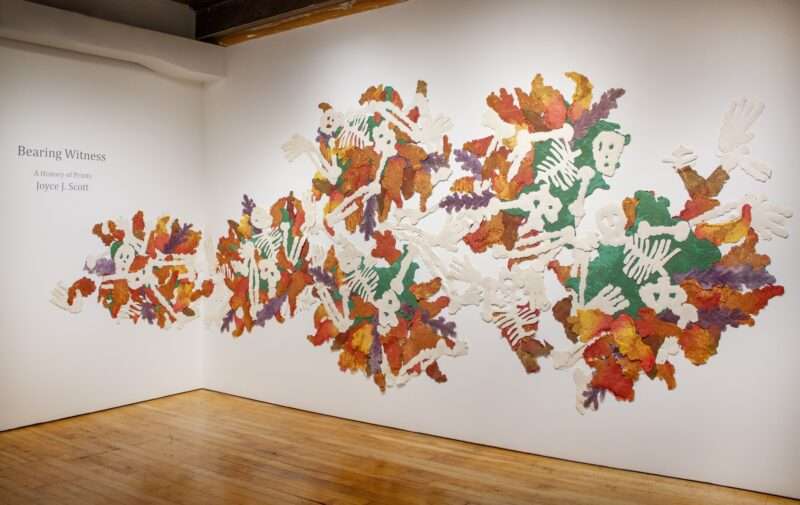
The print exhibition at Goya is a companion to the retrospective and is very strong. One large unframed multimedia work that covers a large wall and part of another, “Sixteen Days in His Life,” is a dynamic composition that is made up of several separate prints. From the 1990s, it shares some of the images and themes that permeate her practice. In discussion with her friend and gallerist, Amy Raehse, Scott comments that the work generally fits into her theme of “walking a mile in someone’s shoes,” a comment on the human condition. This work has not been on view for many years, presenting a unique opportunity for those interested in the artist’s work in addition to artists and viewers who enjoy multimedia constructions.
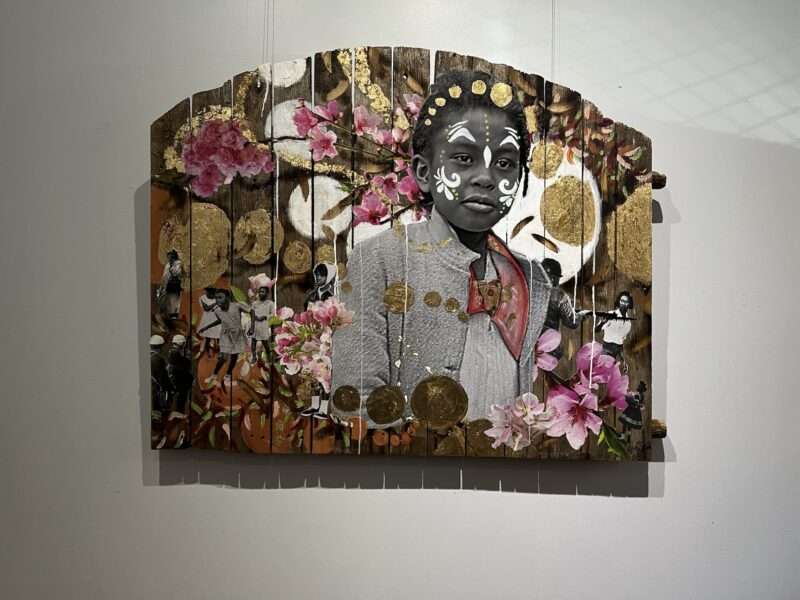
Also, while in Baltimore, you might want to make an appointment at Galerie Myrtis which displays the work of artists of color. I recently visited to see a one-person exhibition by Philadelphia artist, Lavett Ballard, whose work has an Afrofuturist sensibility. Ballard utilizes historical images of African Americans to present a positive view and to imagine a confident future. They are decorative combinations of photo collages, gold leaf, and paint.
*Joyce J. Scott, Walk a Mile in my Dreams, Catharine Manchanda and Cecilia Wichmann, editors. Seattle Art Museum and Baltimore Museum of Art, New Haven and London: Yale University Press, 2024.
Read more about Lavett Ballard on Artblog.
Read more articles by Susan Isaacs on Artblog.
More information about the exhibitions covered in this review
Joyce J. Scott: Walk a Mile in My Dreams
March 24, 2024 — July 14, 2024
Baltimore Museum of Art
Bearing Witness: A History of Prints by Joyce J. Scott
April 12 – June 12, 2024
Goya Contemporary/Goya Girl Press
Eyewinkers, Tumbleturds, and Candlebugs: The Art of Elizabeth Talford Scott
November 12, 2023 — April 28, 2024, Baltimore Museum of Art
Works by Elizabeth Talford Scott
Panel discussion about Elizabeth Talford Scott’s works
Solo Exhibition – Lavett Ballard
March 30 – May 4, 2024
Galerie Myrtis
2224 North Charles St
Baltimore, MD, 21218 | 410-235-3711
Additional Note
In 2017, Susan Isaacs curated an exhibition, Dark Humor, with a catalog publication of the work of Joyce J. Scott and Peter Williams at Towson University.
Isaacs continues her interest in this MacArthur Award-winning artist, visiting her 50-year retrospective on view at the Baltimore Museum of Art. Scott’s work is in many museum collections across the United States, including locally the Philadelphia Museum of Art and the Delaware Art Museum, and her work has been shown around the world. Regionally, her work has been exhibited at the Philadelphia Museum of Art, the Pennsylvania Academy of Fine Arts, the Delaware Art Museum, the Snyderman Gallery, Franklin and Marshall College, the Helen Drutt Gallery, Moore College of Art & Design, the African American Museum, and the National Liberty Museum.
While Joyce J. Scott is a Baltimore-based artist who remains committed to living in the city and the neighborhood where she grew up, her career is international. She has been represented for 25 years by the Baltimore Gallery, Goya Contemporary where her work is also on view in two excellent exhibitions, one of which is discussed here.


